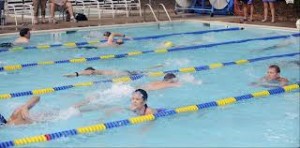 When a pool swim is offered as the first leg of a triathlon, it is often billed as “perfect for beginners.” Other than the fact that you have the ability to hold on to the wall after each length, a serpentine-style swim can sometimes feel a little rough because the pool suddenly becomes a very crowded place. But a little know-how can go a long way to make a serpentine-style pool swim an enjoyable one.
When a pool swim is offered as the first leg of a triathlon, it is often billed as “perfect for beginners.” Other than the fact that you have the ability to hold on to the wall after each length, a serpentine-style swim can sometimes feel a little rough because the pool suddenly becomes a very crowded place. But a little know-how can go a long way to make a serpentine-style pool swim an enjoyable one.
A serpentine swim begins in the far end lane of the pool. Swimmers are normally queued in a long line on the pool deck according to their start time (often seeded based on a time you give when filling out your race application). Swimmers then enter the water one at a time and begin swimming. There is normally a standard interval between swimmers (every 15 seconds, for example).
You will find one of two scenarios after the start depending on the number of lanes at the pool and the distance of the swim. The best course set-up involves one-way swimming, meaning all swimmers travel in one direction down a lane, duck under the lane lines and swim back in the opposite direction in a different lane. You continue this way (swimming one length, ducking under the lane lines, and swimming in the next lane), until you reach the other side of the pool.
The nice part about this arrangement is that in the event you need to pass someone, you can do so easily by moving to the other side of the swimmer and making the pass. Everyone is swimming in the same direction, so this is usually relatively easy.
The second scenario is trickier. This involves swimming one length of the pool on one side of the lane and then returning down the pool in the same lane – just on the other side. Now you have swimmers in the same lane moving in opposite directions. This would work nicely if everyone swam at the same pace. However, passing is inevitable. If two swimmers decide to pass at the same time and are moving in opposite directions, suddenly, you are four abreast in one lane! Also, even in non-passing situations, swimmers can get off course and head-on collisions are possible.
It’s a good idea to incorporate open-water sighting techniques in this case. Lift your head as if sighting for a buoy in the open water to see what the traffic looks like in front of you. If you want to pass someone, it’s good to check first if someone is doing the same thing in the opposite direction.
In both serpentine swim scenarios, the water gets pretty churned up, even with the lane lines present to dissipate some of the wave action. Also, there is plenty of contact as you meet people at the walls or in passing situations. Treat this as you would in a mass start by relaxing your recovery arms and flowing with the contact.
When it’s time to cross the lane line in either scenario, the fastest way to do so is to push off from your present lane and proceed diagonally into the adjacent lane. If it’s your first time doing this or you’re nervous about a diagonal push-off, then there is nothing wrong with ducking under the lane line first before pushing off in the opposite direction.
If you’re thinking of entering a triathlon that incorporates a pool swim, and it is your very first triathlon, look at the course description first. Perhaps a course that allows one-way traffic only in each lane would be a gentler introduction to the swim discipline of the sport.



Pingback: Fall Race Season is Here!! | Balancing Mommy
Wonderful! I’m so glad you found it helpful!